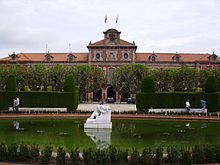Parlament de Catalunya
|
Parliament of Catalonia Parlament de Catalunya |
|
|---|---|
| 11th Legislature | |
 |
|
| Type | |
| Type | |
| History | |
| Founded | 1932 (exiled between 1939 and 1980) |
| Leadership | |
|
Anna Simó (JxSÍ)
David Pérez Ibáñez (PSC) Joan Josep Nuet i Pujals (CSQP) Ramona Barrufet i Santacana (JxSÍ) Since October 26, 2015 |
|
| Structure | |
| Seats | 135 |
 |
|
|
Political groups
|
Government (62):
Confidence and supply (10):
Opposition (63): |
| Committees |
22
|
| Elections | |
| Party-list proportional representation | |
|
Last election
|
September 27, 2015 |
|
Next election
|
On or before November 11, 2019 |
| Meeting place | |
 |
|
| Palau del Parlament de Catalunya, Parc de la Ciutadella, Barcelona, Catalonia, Spain | |
| Website | |
| www.parlament.cat | |
Government (62):
Confidence and supply (10):
Opposition (63):
The Parliament of Catalonia (Catalan: Parlament de Catalunya, IPA: [pərɫəˈmen də kətəˈɫuɲə]) is the unicameral legislature of Catalonia (autonomous community of Spain). It is formed by 135 members ("diputats"), who are elected every four years or after extraordinary dissolution, chosen by universal suffrage in lists with four constituencies, the Catalan provinces. The Parliament building is located in Ciutadella park, Barcelona.
The most recent parliamentary elections were held on 27 September 2015.
The first representative and legislative bodies in Catalonia were the Peace and Truce of God Assemblies (assemblees de pau i treva), of which the earliest record dates from 1027. These were originally ad hoc, local meetings convened by the Church (Oliba, Bishop of Vic, who died in 1046, was a notable instigator) but progressively became subsumed into the court of the Counts of Barcelona. The first Catalan legal code, the Usatges de Barcelona, was promulgated by Count Ramon Berenguer I based on the decisions of these assemblies.
Although the Counts of Barcelona, also Kings of Aragon from 1137, had greatly extended the territory under their control, their financial and military power was quite limited, partly because of their former status as vassals of the Carolingian dynasty. Their personal resources were particularly insufficient in periods of economic crisis or military expansion, of which they were many from the twelfth to the fifteenth centuries. The need to secure troops and revenue led to the steady expansion of the royal court and a formalisation of its procedures. It came to be referred to as the Cort General de Catalunya or Corts catalanes (Catalan Courts), and was endowed with formal procedures, effectively a written constitution, by King Peter III of Aragon in 1283, making from this institution the policemaking and legislative body of the Principality of Catalonia.
...
Wikipedia
